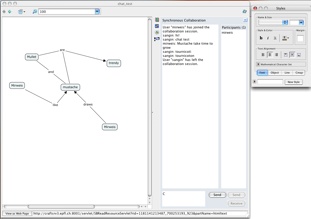Novak, J. D. and, J. Canas (2006). The theory underlying concept maps and how to construct them. Technical Report IHMC CmapTools 2006-01, Florida Institute for Human and Machine Cognition, Pensacola, FI, USA. [pdf]
———
This tech report describes CMapTools, a widespear utility that helps building concept maps. One interesting features of CMapTools is that it allows the users to build maps collaboratively giving them support to a shared display and to a chat channel. The messages in the chat are not connected with the elements in the map.
Concept maps are graphical tools for organizing and representing knowledge. They include concepts, usually enclosed in circles or boxes of some type, and relationships between concepts indicated by a connecting line linking two concepts. Words on the line, referred to as linking words or linking phrases, specify the relationship between the two concepts. We define concept as a perceived regularity in events or objects, or records of events or objects, designated by a label. The label for most concepts is a word, although sometimes we use symbols such as + or %, and sometimes more than one word is used. Propositions are statements about some object or event in the universe, either naturally occurring or constructed. Propositions contain two or more concepts connected using linking words or phrases to form a meaningful statement. Sometimes these are called semantic units, or units of meaning.
![]() Tags: collaboration tools, Computer Supported Collaborative Work, Computer-Mediated Communication, education, learning technology
Tags: collaboration tools, Computer Supported Collaborative Work, Computer-Mediated Communication, education, learning technology

